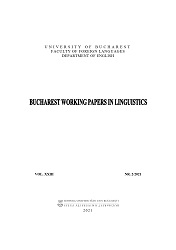Denominal verbs and creativity in child Romanian
Denominal verbs and creativity in child Romanian
Author(s): Adina Camelia BleotuSubject(s): Language studies, Morphology, Semantics, Language acquisition, Cognitive Psychology, Developmental Psychology
Published by: Editura Universităţii din Bucureşti
Keywords: denominal verbs; L1 acquisition; Romanian; literal interpretation; figurative interpretation;
Summary/Abstract: The current paper looks at the meaning of denominal verbs, i.e. verbs derived from nominal roots, through an experiment testing how Romanian children (Mean age: 4, Age range: 3-5) and adults understand nonce (non-existent) denominal verbs created from existing nouns such as a cireşi ‘to cherry’ or a vulpi ‘to fox’. We show that children tend to be more “literal” in their interpretation, understanding such novel denominal verbs as actions/processes involving the actual entity denoted by the nominal root. In contrast, adults prefer ‘figurative’ interpretations in certain contexts, for instance, when the nominal root refers to an animal (a vulpi ‘to behave like a fox’). The results can be explained either cognitively, through children’s preference for literal interpretations at this stage in language acquisition, or structurally, through a preference for a structure which is simpler from a lexico-syntactic point of view, combining mostly action “light” verbs (rather than a whole range of light verbs) with nouns (rather than roots or OBJECT like N entities). In addition, we notice that both children and adults show an animacy bias, mostly producing sentences referring to animate entities, as well as an intransitivity bias, using intransitive verbs more than transitive ones.
Journal: Bucharest Working Papers in Linguistics
- Issue Year: XXIII/2021
- Issue No: 2
- Page Range: 33-49
- Page Count: 17
- Language: English

